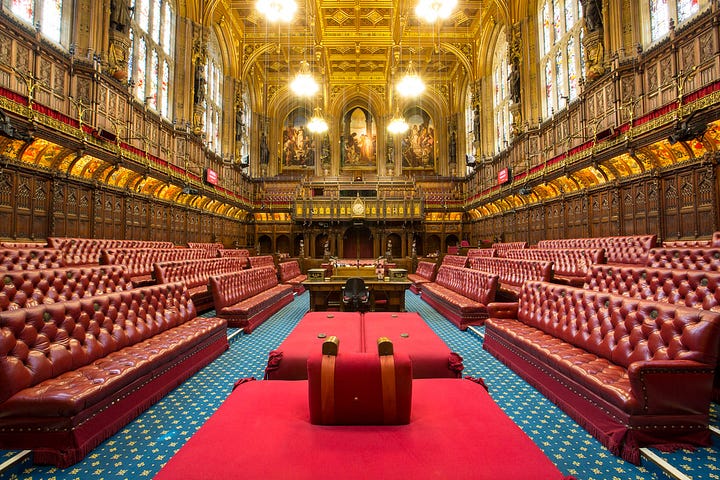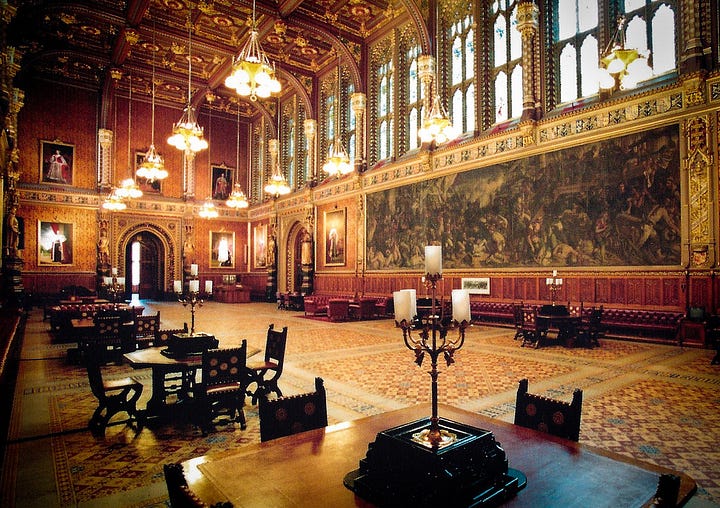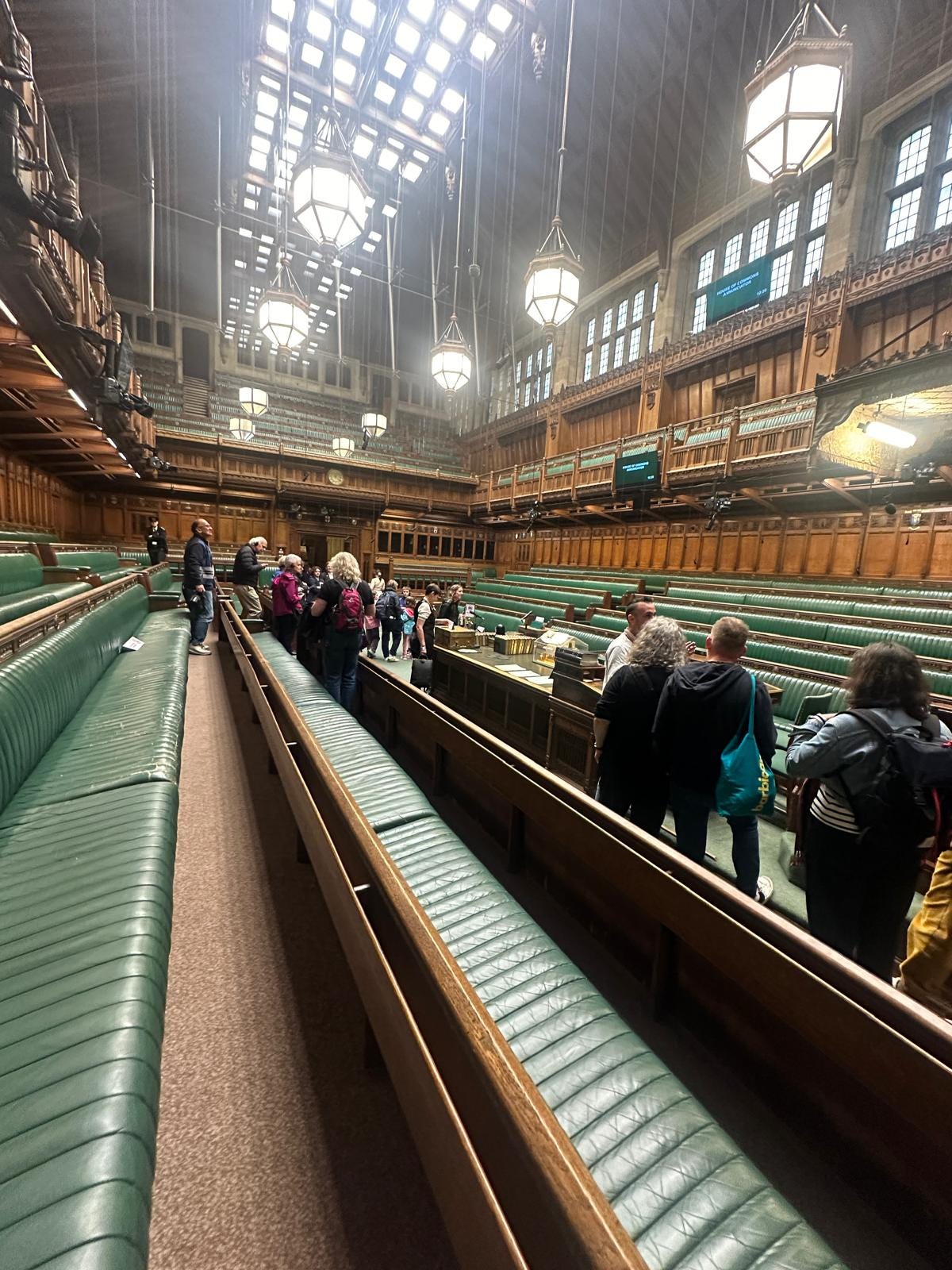On the Palace of Westminster
Reflections on the greatest building in the world
Working in politics has a few things going for it, but the best is free access to roam the Palace of Westminster. The Palace is an imposing neo-Gothic building that dominates the imagination of British politics and serves as the icon for the United Kingdom.
The Palace is seen as purely the domain of politicians, yet every year millions of people pass through the building, admiring the history and brilliance of the Victorians who constructed it.
On a tour you would first enter the building through Westminster Hall. An imposing medieval great hall nearly a thousand years old, far older than most countries. This hall has been used for Royal Courts, Coronation banquets, speeches by international leaders, and even by King Henry VIII for a game of tennis.
It has seen famous events such as the trials of Sir William Wallace, Guy Fawkes, and Charles I; bizarre events like Oliver Cromwell's head being impaled on its spikes for 20 years; and ceremonial events such as the lying in state of Gladstone, Churchill, and Queen Elizabeth II, with over 250,000 people walking through the hall to pay their respects in 2022. The history in the hall is palpable.
From there, you would progress to Central Lobby, a stone octagon making up the core of the Palace from which everything shoots off. This is the midpoint between the House of Lords and the House of Commons and is often where journalists are posted. On your left would be the Commons, a stoic chamber far smaller than you would expect, with iconic green benches - pictured below (which I was promptly told off for taking).
Then on your right would be the House of Lords, a chamber for which the word "opulent" doesn’t quite encapsulate. With a golden throne dominating the chamber and armorial bearings running beneath the sides the galleries featuring sovereigns from Edward III and the Lord Chancellors from 1377 onwards.
Behind the chamber is the Royal Gallery, which is dominated by two of my favorite paintings. One of them, 'The Death of Nelson', depicts the demise of Lord Nelson, shot aboard H.M.S. Victory at the Battle of Trafalgar in 1805. The painting opposite, 'The Meeting of Wellington and Blücher', portrays the meeting of the Duke of Wellington and the Prussian Field Marshal Blücher before defeating Napoleon at the Battle of Waterloo in 1815.


From there, the public areas of the building quickly dwindle, but that is only a small part of it. With 1,100 rooms, 100 staircases, and 3 miles of passageways, the rest of the building is an imposing labyrinth of corridors that encapsulates the tangible aspect of politics.
I am exceptionally lucky to have worked in the literal bowels of the building, with my boss's old office being directly under the chamber of the House of Commons. I - as a real nerd - have also been fortunate to have explored far more of the palace than most. I have purposely tried to explore as much as possible, which has led me from far above Westminster in the Elizabeth Tower, across to the Lords' offices overlooking the river, to the depths of the basement where I unfortunately had to work. Ive been given access to hidden parts such as the ventilation towers above central lobby and to the majesty of the hidden roof terrace high on the roof of the Palace. The building is a maze, one which I am exceptionally lucky to have been given free rein of, but will probably never fully explore.
The building was clearly designed for an earlier age as it now attempts to cram far too many people into offices far too small. But consequently, with every twist and turn of your journey, you will stumble across something new. A few small favourites that I share with people is the lovely hairdresser's tucked next to one of the cafeterias, or the bath in the House of Lords, or even the MPs' offices shoved high into one of the towers overlooking the river. There is just a majesty to the building that every time I explore, I am full of boyish wonder. Yet the building is at severe risk of disrepair.
The brutal fact of it is that the Palace of Westminster is falling apart. Masonry falling off the building, leaks in the Chamber of the House of Commons, asbestos everywhere, rats quite literally in the cafeteria, elevators constantly failing, toilets that frequently don't flush, heating systems that don't work, masonry uncleaned since it was built nearly 200 years ago, and a constant threat of fires with people on 24-hour watch - fire is what destroyed the previous palace and is the biggest threat currently.
I often tell people this whenever I tour them around the palace, as the grandeur of walking through Westminster Hall, into Central Lobby, and visiting the House of Lords and the Commons dazzles everyone (On a side note, if anyone wants a tour, I am more than happy to provide; it is by far my favourite part of my job).
But behind the scenes, the Palace is a shocking mess, unfit for people to work in. Much less the building in which we pass laws. No place better illustrates this than my boss's old office.
When you are made a Minister of State (the second level of the ministerial ladder), you are given the honour of an office in Lower Ministerial Corridor. It is directly below the Chamber with corridors lined with books and beautiful paintings tucked away that the public never gets to see.
On your first day, you would enter your new office through this grand wooden door into a marvellous wooden-floored room, with a large desk and a lovely intricate table. You look out your enormous window - which is framed with the 200-year-old masonry of the Palace - and you are within spitting distance of Big Ben. When it rings, it is so loud it is hard to have a conversation.
In that moment, you feel some sense of the grandeur of the British State from a bygone era where the United Kingdom ruled over a quarter of the world, and in that moment, you would be one of the most important people in the country.
Yet, in this office of history, state power, and opulence, used by Ministers of the Crown in His Majesty's Government for nearly 200 years, every time it rained, it leaked through the fire alarm.
The Palace of Westminster is truly a marvel. The experience of exploring late on a Friday night when no one is around is something I will treasure for the rest of my life.
To be at the heart of British democracy in my early 20s is truly amazing and is something I will find very hard to give up. And it is why I relate to Members of Parliament not wanting to leave the Palace.
Currently, there is a programme going on called "Restoration and Renewal". It was created with the express purpose of coordinating the restoration of the Palace and the rest of the parliamentary estate as a whole (There, in fact, is another 16 buildings in use).
There are three proposals on the board. Firstly, a full decant, which would require everyone moving out for up to 20 years at a cost of up to £13 billion. Secondly, partially decanting, which could be 40 years of work and cost up to £18 billion. Lastly, just making it work, which would mean working around everyone as it is currently, which could take up to 76 years. The decision has been delayed for quite a while as no Member of Parliament wants to take the pain of never being in the Palace.
Even worse, the final option won't be decided on until the end of 2025, and work will only start in 2029, which places the building at a further risk of burning down. This would be a tragic end for one of the greatest buildings in the world.
And on that depressing note, I'm going to go explore once again, whilst I still can.


